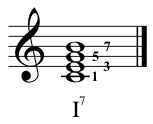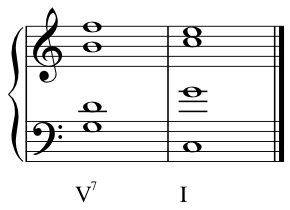If you add the seventh from the root to a triad, you get a seventh chord:

Different chords of the scale have different sevenths. For the major scale, they are
| Chord | Seventh |
|---|---|
| I7 | Major |
| ii7 | Minor |
| iii7 | Minor |
| IV7 | Major |
| V7 | Minor |
| vi7 | Minor |
| vii7 | Minor or Diminished |
Notice that V7 is the only major chord of the key with a minor seventh. This means it is a defining chord of the key. In fact since it contains both the fourth and the seventh degree of the scale, this so-called Dominant Seventh unambiguously defines the key. For example in the key of C, the Dominant seventh consists of the notes G, B, D and F. The B♮ means we cannot be in a flat key, because B♭ is the first flat, and the F♮ means we cannot be in a sharp key, because F♯ is the first sharp.
The Dominant Seventh is the most common seventh, and the progression of dominant seventh to tonic is the strongest progression in Western tonal music:

You may be thinking Chord vii also contains those notes, and you’re right, however if we choose the diminished seventh of vii (which usually sounds better than the minor seventh) then we have a chord completely composed of consecutive minor thirds, and that chord can be the viio7 of four separate keys (this is useful in modulation, discussed later).
Because there are four distinct notes in a seventh chord, there are three inversions, as well as root position:

Using I as an example, the root position is just written I7, as the 3 and the 5 are taken as read. Likewise the first inversion is I65, the second inversion is I43, and the third inversion just I2. There is a useful mnemonic sequence to remember these: 7, 6-5, 4-3, 2.
